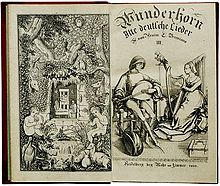
Back Literatur der Romantik ALS Lliteratura del Romanticismu AST Literatura romàntica Catalan Romantismus (literatura) Czech Ρομαντισμός (λογοτεχνία) Greek Literatura del Romanticismo Spanish ادبیات عاشقانه Persian Romantiikka (kirjallisuus) Finnish Literatura do Romanticismo Galician Letteratura romantica Italian

In literature, Romanticism found recurrent themes in the evocation or criticism of the past, the cult of "sensibility" with its emphasis on women and children, the isolation of the artist or narrator, and respect for nature. Furthermore, several romantic authors, such as Edgar Allan Poe, Charles Maturin and Nathaniel Hawthorne, based their writings on the supernatural/occult and human psychology. Romanticism tended to regard satire as something unworthy of serious attention, a view still influential today.[1] The Romantic movement in literature was preceded by the Enlightenment and succeeded by Realism.
Some authors cite 16th-century poet Isabella di Morra as an early precursor of Romantic literature. Her lyrics covering themes of isolation and loneliness, which reflected the tragic events of her life, are considered "an impressive prefigurement of Romanticism",[2] differing from the Petrarchist fashion of the time based on the philosophy of love.
The precursors of Romanticism in English poetry go back to the middle of the 18th century, including figures such as Joseph Warton (headmaster at Winchester College) and his brother Thomas Warton, Professor of Poetry at Oxford University.[3] Joseph maintained that invention and imagination were the chief qualities of a poet. The Scottish poet James Macpherson influenced the early development of Romanticism with the international success of his Ossian cycle of poems published in 1762, inspiring both Goethe and the young Walter Scott. Thomas Chatterton is generally considered the first Romantic poet in English.[4] Both Chatterton and Macpherson's work involved elements of fraud, as what they claimed was earlier literature that they had discovered or compiled was, in fact, entirely their own work. The Gothic novel, beginning with Horace Walpole's The Castle of Otranto (1764), was an important precursor of one strain of Romanticism, with a delight in horror and threat, and exotic picturesque settings, matched in Walpole's case by his role in the early revival of Gothic architecture. Tristram Shandy, a novel by Laurence Sterne (1759–67), introduced a whimsical version of the anti-rational sentimental novel to the English literary public.
- ^ Sutherland, James (1958) English Satire Archived 2022-12-04 at the Wayback Machine p. 1. There were a few exceptions, notably Byron, who integrated satire into some of his greatest works, yet shared much in common with his Romantic contemporaries. Bloom, p. 18.
- ^ Paul F. Grendler, Renaissance Society of America, Encyclopedia of the Renaissance, Scribner, 1999, p. 193
- ^ John Keats. By Sidney Colvin, p. 106. Elibron Classics
- ^ Thomas Chatterton, Grevel Lindop, 1972, Fyffield Books, p. 11
© MMXXIII Rich X Search. We shall prevail. All rights reserved. Rich X Search